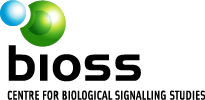BIOSS-A

Membranes and protein–lipid interactions in signalling
BIOSS-B

Oncogenic signalling
BIOSS-C

Re-building & biotechnology
BIOSS

From Analysis
to Synthesis
Dr. Sebastian Arnold

Dr. Sebastian Arnold
Institute of Experimental and Clinical Pharmacology and Toxicology
University of Freiburg
During embryogenesis cells of the developing organism become progressively restricted in their developmental potential. Pluripotent cells of the epiblast get specified to different lineages according to their position within the embryo at certain critical time points to establish the various different cell types of the body. This initial lineage restriction also defines the primary body pattern, lays down the set of different cell types required for all following steps during development and is maintained throughout the entire lifespan. Lineage specification is influenced by dynamic cell-cell interactions and extracellular stimuli - e.g. growth-factors or extracellular components – to define the route of cells from stem- and progenitor cells to terminal differentiation.
Our group is mainly interested in the processes that shape the embryo during the time when pluripotent progenitor cells of the epiblast become specified to the three germ layers, namely ectoderm, mesoderm and endoderm. We aim to contribute to the understanding of this gastrulation process by using combinations of mouse genetics, embryo imaging techniques and in vitro cell culture systems. Enhancing current knowledge of early cell type specification events will be instrumental in developing new strategies to use stem- and progenitor cells, such as embryonic stem (ES) cells and induced pluripotent cells (iPCs) for novel approaches in regenerative medicine and tissue replacement.
10 selected publications
- Direct reprogramming of fibroblasts into renal tubular epithelial cells by defined transcription factors.
Kaminski MM, Tosic J, Kresbach C, Engel H, Klockenbusch J, Müller AL, Pichler R, Grahammer F, Kretz O, Huber TB, Walz G, Arnold SJ, Lienkamp SS (2016).
Nat Cell Biol. 18(12):1269-1280 - Cyclin O (Ccno) functions during deuterosome-mediated centriole amplification of multiciliated cells.
Funk MC, Bera AN, Menchen T, Kuales G, Thriene K, Lienkamp SS, Dengjel J, Omran H, Frank M, Arnold SJ (2015).
EMBO J. 2015;34(8):1078-89. - Lysine-specific demethylase 1 regulates differentiation onset and migration of trophoblast stem cells.
Zhu D, Hölz S, Metzger E, Pavlovic M, Jandausch A, Jilg C, Galgoczy P, Herz C, Moser M, Metzger D, Günther T*, Arnold SJ*, Schüle R* (2014).
Nat Commun. 5:3174. * corresponding authors - Differentiation of type 1 ILCs from a common progenitor to all helper-like innate lymphoid cell lineages.
Klose CSN, Flach M, Möhle L, Rogell L, Hoyler T, Ebert K, Fabiunke C, Pfeifer D, Sexl V, Fonseca-Pereira D, Domingues RG, Veiga-Fernandes H, Arnold SJ, Busslinger M, Dunay IR, Tanriver Y, Diefenbach A (2014).
Cell. 157(2):340-356 - The T-box transcription factor Eomesodermin acts upstream of Mesp1 to specify cardiac mesoderm during mouse gastrulation.
Costello I, Pimeisl IM, Dräger S, Bikoff EK, Robertson EJ, Arnold SJ (2011).
Nat Cell Biol. 13(9):1084-91 - Pluripotency factors regulate definitive endoderm specification through eomesodermin.
Teo AK, Arnold SJ, Trotter MW, Brown S, Ang LT, Chng Z, Robertson EJ, Dunn NR, Vallier L (2011).
Genes Dev. 25(3):238-50. - Making a commitment: cell lineage allocation and axis patterning in the early mouse embryo.
Arnold SJ, Robertson EJ (2009).
Nat Rev Mol Cell Biol. 10(2):91-103 - Pivotal roles for eomesodermin during axis formation, epithelium-to-mesenchyme transition and endoderm specification in the mouse.
Arnold SJ, Hofmann UK, Bikoff EK, Robertson EJ (2008).
Development. 135(3):501-11. - The T-box transcription factor Eomes/Tbr2 regulates neurogenesis in the cortical subventricular zone.
Arnold SJ, Huang GJ, Cheung AF, Era T, Nishikawa S, Bikoff EK, Molnár Z, Robertson EJ, Groszer M (2008).
Genes Dev. 22(18):2479-84 - Brachyury is a target gene of the Wnt/beta-catenin signaling pathway.
Arnold SJ, Stappert J, Bauer A, Kispert A, Herrmann BG, Kemler R (2000).
Mech Dev. 91(1-2):249-58.
